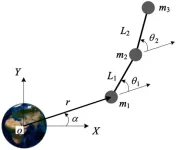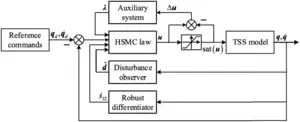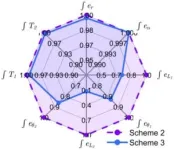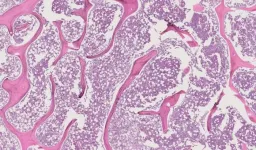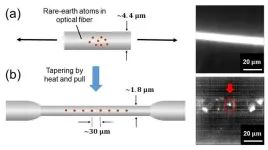(Press-News.org)
Recently, the tethered satellite system (TSS) has been used in Earth observations, space interferometry and other space missions, due to potential merits of TSS. The tethered TSAR (tomographic synthetic aperture radar) system is a group of tethered SAR satellites that can be rapidly deployed and provide a stable baseline for 3-dimensional topographic mapping and moving target detection. Successful deployment is critical for TSAR tethered system. Several control methods, including length, length rate, tension, and thrust-aided control, have been proposed over the years. Among them, adjusting tension is a viable yet challenging approach due to tether's strong nonlinearity and underactuated traits. Current tether deployment schemes focus on two-body TSS, with little emphasis on multi-TSSs. In a research article recently published in Space: Science & Technology, the team led by Zhongjie Meng from Northwestern Polytechnical University develops a new deployment strategy for a 3-body chain-type tethered satellite system in a low-eccentric elliptical orbit.
First, authors establishe the motion model of a 3-body chain-type TSS in a low-eccentric elliptical orbit. Two assumptions are made: (a) the tethers are massless; (b) only the planar motion is considered. The proposed model consists of 3 point masses (m1, m2, and m3) and 2 massless tethers (L1 and L2), as illustrated in Fig. 1. The orbit of m1 is defined by its orbital geocentric distance r and true anomaly α; the position of m2 relative to m1 is determined by tether L1 and in-plane libration angle θ1; the position of m3 relative to m2 is determined by L2 and θ2. The dynamic model of 3-body TSS is derived using Lagrangian formulation, and the motion equations are expressed in the Euler–Lagrange form as M(q)q̈ + C(q,q̇)q̇ + G(q) = Q with generalized coordinates q = (r, α, θ1, θ2, L1, L2)T. Since the TSS model in is a typical underactuated systems, the generalized coordinates are decomposed into 2parts, i.e., the actuated configuration vectors (qa = (L1, L2)T) and the unactuated configuration vectors (qua = (r, α, θ1, θ2)T).
Then, authors introduce a novel deployment scheme for the 3-body chain-type TSS. Sequential deployment strategy, ejecting satellites one by one, is employed to avoid collisions, this method utilizes the deployment techniques for a 2-body system directly; Poincaré’s recurrence theorem, Poisson stability, and the Lie algebra rank condition (LARC) are used to analyze the controllability of underactuated TSS system. A combination of exponential and uniform deployment law yields a simple and efficient deployment scheme, providing the requisite reference trajectory for satellite deployment. During the deployment process, positive tension must be guaranteed due to the characteristic tether, and to avoid tether rupture, tension could not exceed the given boundaries. So, deployment process can be simplified to a underactuated control with constrained control inputs. To address this limitation, a hierarchical sliding mode controller (HSMC) was designed for accurate trajectory tracking. The controller framework is shown in Fig. 2. In the controller, an auxiliary system is introduced to mitigate the input saturation caused by tether tension constraint. A 3-layer sliding surface for the whole TSS is constructed. A disturbance observer (DO) was introduced to estimate second derivative signal q̈. The uncertainty of sliding surface and its time derivative for orbit motion (r,α) are estimated by a sliding mode-based robust differentiator.
Finally, authors present the numerical simulation and draw the conclusion. To verify the effectiveness of the proposed deployment scheme (marked as Scheme 3), 2 alternative deployment schemes were used for comparison. In Scheme 1, the system is regarded as 2 independent 2-body, in which the tether length L2 remains constant, and only tension T1 is adjustable. In Scheme 2, the system is regarded as two 2-body, but the coupling between adjacent tethers is neglected. That is to say, tether L1 only affects angle θ1 and L2 only affects θ2. In Schemes 1 and 2, the deployment controller in the literature (Murugathasan L, Zhu ZH. Deployment control of tethered space systems with explicit velocity constraint and invariance principle. Acta Astronaut. 2019;157:390–396.) is adopted. The results show that the tether deployment error and libration angle converge to zero asymptotically in 3 h (a little more than one orbital period) under Scheme 3, and the deployment error under Schemes 1 and 2 is quite larger than that under the proposed Scheme 3. A comparison is made between Schemes 2 and 3 based on the integration of tracking error and tether tension, and the normalized results are illustrated in Fig. 3. Compared to Scheme 2, the proposed HSMC explicitly takes the 3-body TSS couple into account, resulting in faster and more accurate tether deployment with a smaller in-plane angle, which further shows that a fairly better deployment process is achieved under the proposed scheme, and confirm the effectiveness of the proposed deployment scheme.
Reference
Article Title: Deployment of Three-Body Chain-Type Tethered Satellites in Low-Eccentricity Orbits Using Only Tether
Journal: Space: Science & Technology
Authors: Cheng Jia, Zhongjie Meng*, and Bingheng Wang
Corresponding Author Affiliation: School of Astronautics, Northwestern Polytechnical University, Xi'an, China.
Link: https://spj.science.org/doi/10.34133/space.0070
END
Research out of Drexel University’s College of Engineering suggests that over the next two decades people living in the Schuylkill Watershed, which includes Philadelphia, could experience as many as 82 more days of water shortfalls due to localized weather impacts of climate change. The projections, which account for changes in population, land use, and climate, indicate that — due to more frequent extreme weather events associated with climate change — the watershed may only be able to meet demand about 67% of the time, a drop of 22% from its current reliability.
Published in the journal Water, the paper ...
Researchers at National Jewish Health found that Indigenous coal miners may develop disabling black lung disease but are less likely to qualify for medical benefits using currently required lung function standards rather than standards specific to Indigenous populations.
Black lung (also called coal worker’s pneumoconiosis) is a debilitating respiratory illness that can occur several decades after a miner’s first exposure to coal mine dust. Disease severity can be influenced by adequacy of dust controls, medical surveillance programs ...
Researchers at the University of Illinois Chicago have received a $3.12 million National Institutes of Health grant to study whether acupuncture can alleviate chest pain caused by stable angina. Stable angina is defined as predictable chest pain during exertion or when under mental or emotional stress and is a condition that affects millions of Americans.
A large body of research has shown that acupuncture can help mitigate many types of chronic pain. But little is known about its effect on ischemic pain, which is caused when the heart isn’t getting enough oxygen, as is the case with stable angina.
The two-site study will be led by principal investigators Judith Schlaeger, ...
Washington, D.C.—A new study published in Applied and Environmental Microbiology, a journal of the American Society for Microbiology, provides the first characterization of the coral microbiome under hypoxia, insufficient oxygen in the water. The research is an initial step toward identifying potential beneficial bacteria for corals facing this environmental stressor.
The researchers conducted the study because of the increasing awareness of the impact of the microbiome on host health. For example, a healthy human gut microbiome plays key roles ...
A research team at Johns Hopkins Medicine has created and trained a machine learning model to calculate percent necrosis (PN) — or, what percentage of a tumor is “dead” and no longer active — in patients with osteosarcoma, a type of bone cancer. The model’s calculation was 85% correct when compared to the results of a musculoskeletal pathologist. Upon removing one outlier, the accuracy rose to 99%.
A post-chemotherapy PN calculation helps provide the patient with a prognosis for survival. For example, a PN of 99% indicates that 99% of the tumor is dead, suggesting chemotherapy was effective and the patient has improved ...
INDIANAPOLIS — Regenstrief Institute’s Susan Hickman, PhD, has been elected as a fellow of the Gerontological Society of America (GSA). Dr. Hickman will be inducted on November 9 into the social research, policy and practice section of the GSA College of Fellows during the society’s 2023 annual scientific meeting.
In addition to being director and a research scientist with the IU Center for Aging Research at Regenstrief Institute, Dr. Hickman is a professor at Indiana University School of Nursing, the Pettinga Chair in Aging Research with the Indiana University School of Medicine and the co-director of the IUPUI ...
DALLAS, Nov. 2, 2023 — Medical experts note that hormone and body composition changes during the transition to menopause can increase the risk of developing heart disease after menopause.[1] The American Heart Association, a global force for healthier lives for all, offers tips to support women’s heart health during this transition.
“More women in the U.S. are living longer, and a significant portion of them will spend up to 40% of their lives postmenopausal,” said Brooke Aggarwal, Ed.D., M.S., F.A.H.A., assistant professor of medical sciences in Cardiology ...
The discharge of organic effluents—biodegradable waste materials from plants and animals—into freshwater bodies is a significant environmental concern, affecting the health and sustainability of these aquatic ecosystems. However, the methods currently available for inspecting water quality are complex and costly.
In this regard, researchers from Ritsumeikan University, Japan, have recently developed a self-powered, inexpensive, and floating biosensor for monitoring water quality at the input of freshwater lakes and rivers. This paper was made available online on September 9, 2023, and was published in Volume 200 of the Biochemical Engineering ...
Quantum-based systems promise faster computing and stronger encryption for computation and communication systems. These systems can be built on fiber networks involving interconnected nodes which consist of qubits and single-photon generators that create entangled photon pairs.
In this regard, rare-earth (RE) atoms and ions in solid-state materials are highly promising as single-photon generators. These materials are compatible with fiber networks and emit photons across a broad range of wavelengths. Due to their wide spectral range, optical fibers ...
In a world increasingly aware of the environmental challenges posed by microplastics, a pioneering study conducted by Ruxandra Malina Petrescu-Mag from Babes-Bolyai University, and published in PeerJ Life & Environment, sheds new light on the impact of media narratives on public perception and awareness of microplastic risks.
Microplastics - tiny plastic particles that pollute both terrestrial and marine ecosystems - have garnered significant scientific, media, and public attention in recent years. However, this study reveals a lack of consensus between the scientific community and the media, particularly when it comes to how ...
